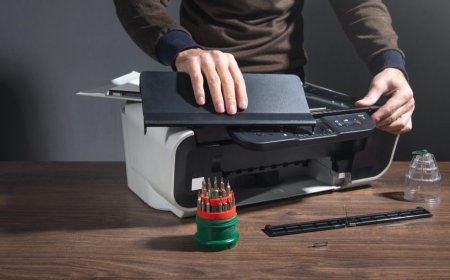How to Use RTC Bikes Around Downtown in Las Vegas
How to Use RTC Bikes Around Downtown in Las Vegas Las Vegas is a city of contrasts—glittering resorts, bustling casinos, and sprawling highways often dominate the skyline. But beneath the neon glow lies a growing network of sustainable transportation options designed to help residents and visitors navigate the urban core with ease. Among these, RTC Bikes stands out as a practical, affordable, and
How to Use RTC Bikes Around Downtown in Las Vegas
Las Vegas is a city of contrasts—glittering resorts, bustling casinos, and sprawling highways often dominate the skyline. But beneath the neon glow lies a growing network of sustainable transportation options designed to help residents and visitors navigate the urban core with ease. Among these, RTC Bikes stands out as a practical, affordable, and eco-friendly solution for short trips around Downtown Las Vegas. Whether you’re a tourist exploring the Fremont Experience, a local commuting to work, or a digital nomad seeking a scenic ride between coffee shops and art galleries, RTC Bikes offers a seamless way to move through the city without traffic, parking hassles, or carbon emissions.
Unlike traditional bike-share systems that require long-term commitments or complex memberships, RTC Bikes operates on a flexible, pay-as-you-go model integrated with modern technology. Launched and maintained by the Regional Transportation Commission of Southern Nevada, the program is part of a broader initiative to reduce congestion, improve air quality, and promote active transportation. With over 30 strategically placed docking stations in Downtown, the Arts District, and along the Las Vegas Strip corridor, RTC Bikes connects key destinations—from the Neon Museum to the Smith Center, from the Las Vegas City Hall to the Arts District’s vibrant murals.
This guide provides a comprehensive, step-by-step walkthrough on how to use RTC Bikes effectively. You’ll learn how to locate stations, unlock bikes, plan routes, avoid common pitfalls, and maximize your experience—all while staying safe and informed. By the end, you’ll not only know how to ride an RTC Bike, but also how to make it a reliable part of your daily or occasional Las Vegas routine.
Step-by-Step Guide
Step 1: Understand the RTC Bikes System
RTC Bikes is a public bike-share program operated by the Regional Transportation Commission of Southern Nevada. It functions similarly to other city bike-share systems like Citi Bike in New York or Divvy in Chicago, but is tailored to the unique layout and needs of Las Vegas. The system consists of electric-assist bicycles (e-bikes) and traditional pedal bikes, distributed across 30+ docking stations primarily concentrated in Downtown Las Vegas and adjacent neighborhoods.
Each bike is equipped with a built-in GPS tracker, an integrated lock, and a digital display that shows battery level (for e-bikes) and trip duration. The docking stations are solar-powered, weather-resistant kiosks with clearly labeled slots for bike return. Stations are spaced approximately 0.5 to 1.5 miles apart, ensuring coverage across major pedestrian corridors and transit hubs.
Unlike private bike rentals, RTC Bikes does not require you to reserve a specific bike in advance. Instead, bikes are available on a first-come, first-served basis. The system is designed for short-term use—ideal for trips under 30 minutes. Longer rides incur additional fees, so it’s best to plan accordingly.
Step 2: Choose Your Access Method
RTC Bikes offers two primary ways to access bikes: via the official mobile app or through a physical kiosk at any station.
Option A: Using the RTC Bikes Mobile App
The most efficient method is downloading the free “RTC Bikes” app from the Apple App Store or Google Play Store. Once installed, create an account using your email address and a secure password. You’ll be prompted to add a payment method—credit or debit cards are accepted. The app displays a live map of all active stations, showing real-time availability of bikes and open docks.
After logging in, select “Unlock a Bike” from the home screen. The app will prompt you to scan the QR code located on the bike’s handlebar or frame. Once scanned, the bike’s lock will automatically release. You’ll receive a confirmation notification and your trip will begin tracking immediately.
Option B: Using the Station Kiosk
If you don’t have a smartphone or prefer not to use the app, each docking station has a touchscreen kiosk. Press the “Rent a Bike” button, then select “Pay with Credit Card.” Follow the on-screen prompts to enter your card information and confirm your rental. The kiosk will issue a 5-digit code, which you must enter on the bike’s keypad (located near the lock). Once entered correctly, the lock disengages.
While the kiosk method works reliably, it’s slower than the app and doesn’t provide trip analytics or station availability updates during your ride. For optimal efficiency, the app is strongly recommended.
Step 3: Locate a Station Near You
Before heading out, use the RTC Bikes app to find the nearest station. Popular starting points in Downtown Las Vegas include:
- Fremont Street Experience – Near the intersection of 3rd and Fremont
- Las Vegas City Hall – 400 S. 3rd Street
- Smith Center for the Performing Arts – 361 Symphony Park Ave
- Neon Museum – 770 Las Vegas Blvd N
- Arts District – Around the corner of 4th and Carson
- Las Vegas Convention Center – Near the West Hall entrance
Each station is marked with a bright blue sign and a distinctive RTC Bikes logo. Stations are often located near public transit stops, making them ideal for multimodal trips—combine a bus ride with a bike for the last mile.
Pro tip: Always check the app for both available bikes and open docks before arriving. If a station is full, the app will suggest the nearest alternative with open spaces. This prevents wasted time and frustration.
Step 4: Unlock and Inspect the Bike
Once you’ve located your bike, perform a quick visual and functional inspection:
- Check that the chain is properly aligned and not visibly damaged.
- Test the brakes by squeezing the levers—both front and rear should engage smoothly.
- For e-bikes, confirm the battery indicator shows at least 30% charge. A low battery may affect pedal assist performance.
- Ensure the helmet is present (optional, but recommended). RTC Bikes does not provide helmets, so bring your own.
- Verify the seat height is adjustable and locked in place. Most bikes have a quick-release lever under the seat.
If anything appears broken or unsafe—such as a flat tire, broken light, or malfunctioning lock—do not use the bike. Return it to the dock and select another one. Report the issue through the app by selecting “Report a Problem” and following the prompts. This helps maintain system reliability for all users.
Step 5: Ride Safely and Legally
Las Vegas has specific rules for bike riders that must be followed to ensure safety and avoid fines.
- Always ride in the same direction as traffic. Never ride against the flow on one-way streets.
- Use bike lanes when available. Downtown Las Vegas has marked bike lanes on several major roads, including Las Vegas Boulevard, 3rd Street, and Carson Avenue.
- Obey all traffic signals and stop signs. Bikes are considered vehicles under Nevada law.
- Use hand signals to indicate turns. Extend your left arm for a left turn; extend your right arm or raise your left arm upward for a right turn.
- Do not ride on sidewalks in the Downtown core. It’s prohibited by city ordinance and creates hazards for pedestrians.
- Use front and rear lights at night. RTC Bikes are equipped with automatic LED lights that activate when the bike is in motion. However, additional lighting is recommended during low-light conditions.
Speed limits for bikes in urban areas are not strictly enforced, but riding at a controlled pace—especially near crowds, crosswalks, and transit stops—is essential. Avoid using headphones or mobile devices while riding. Stay alert to traffic patterns, opening car doors, and turning vehicles.
Step 6: End Your Ride Properly
To complete your trip, return the bike to any RTC Bikes station with an available dock. Align the bike’s locking mechanism with the empty slot and push firmly until you hear a click. The dock’s LED light will turn green, confirming successful return.
Do not leave the bike unlocked, leaning against a pole, or chained to a non-designated object. Improper parking may result in a $25 fee and could lead to removal of the bike by city staff.
After docking, check the app to confirm your trip has ended and your payment has been processed. You’ll receive a summary including duration, distance, and cost. If the system shows your trip as still active after docking, re-dock the bike or contact support through the app immediately.
Step 7: Manage Your Account and Payments
RTC Bikes offers several pricing options:
- Single Ride: $3 for the first 30 minutes. $0.15 per minute after.
- Day Pass: $12 for unlimited 30-minute rides within 24 hours. Ideal for tourists.
- Monthly Membership: $15/month for unlimited 45-minute rides. Best for frequent users.
Payments are processed automatically through your linked card. You can view your ride history, receipts, and spending summary in the app. If you’re a student, senior, or low-income resident, you may qualify for discounted rates—check the app’s “Discounts” section for eligibility details.
Always ensure your payment method is valid and has sufficient funds. Failed transactions may temporarily lock your account until resolved. You can update your payment information at any time in the app’s profile settings.
Best Practices
Plan Your Route Ahead of Time
Las Vegas Downtown is walkable, but distances between attractions can be deceptive under the desert sun. Use Google Maps or the RTC Bikes app to plan your route before departing. Look for bike-friendly roads with protected lanes. Avoid routes with heavy traffic or steep inclines unless you’re experienced. The app’s route planner can suggest optimal paths based on elevation, traffic, and station proximity.
Time Your Rides for Cooler Hours
Temperatures in Las Vegas regularly exceed 100°F during summer months. Ride during early morning (6–9 AM) or late evening (6–9 PM) to avoid heat exhaustion. Carry water—even short rides can be dehydrating. Many stations are near public water fountains or convenience stores where you can refill.
Use the E-Bike Assist Wisely
RTC Bikes’ e-bikes provide pedal-assist up to 20 mph, making hills and longer distances manageable. However, the battery is not infinite. Use the highest assist level only when needed—like climbing the slight incline from Fremont Street toward the Arts District. Lower assist levels extend battery life and allow you to ride farther on a single charge.
Lock Your Belongings
While RTC Bikes are secure when docked, never leave personal items unattended on the bike. Use a small backpack or saddlebag to carry essentials. Avoid placing phones, wallets, or cameras in easily accessible pockets. Theft, while rare, does occur in high-traffic tourist zones.
Know Where to Avoid Riding
Some areas are not ideal for biking:
- Las Vegas Boulevard between Sahara and Russell: High-speed traffic, narrow shoulders, and frequent pedestrian crossings make this zone hazardous.
- Industrial corridors near N. Las Vegas: Poor lighting, lack of bike infrastructure, and heavy truck traffic.
- Highways and overpasses: Biking on I-15, US-95, or the 215 Beltway is illegal and extremely dangerous.
Stick to designated bike corridors and urban streets with lower speed limits.
Be Aware of Parking Restrictions
While RTC Bikes stations are designed for bike parking, some adjacent areas prohibit parking of other vehicles near docks. Do not block ADA ramps, fire hydrants, or bus stops. Violations can lead to citations for nearby property owners—and may result in your bike being moved.
Report Issues Promptly
If a station is broken, a bike is missing, or the app malfunctions, report it immediately through the app. RTC Bikes relies on user feedback to maintain service quality. Your report helps them prioritize repairs and reposition bikes where demand is highest.
Combine with Public Transit
RTC Bikes works seamlessly with the city’s bus network. Many bus routes stop within 200 feet of a bike station. Use the app to find “Transit + Bike” routes—such as taking the Deuce bus to the Strip and biking to the Neon Museum. This combination reduces reliance on cars and makes multi-stop itineraries more efficient.
Tools and Resources
RTC Bikes Mobile App
The official app is your primary tool. It provides real-time station maps, ride history, payment management, and customer support. Download it before arriving in Las Vegas to avoid delays. The app works offline for basic functions like unlocking bikes via QR code.
RTC Bikes Website
Visit rtc.nv.gov/bikes for detailed station maps, pricing, service alerts, and safety guidelines. The site includes downloadable PDF maps of all docking locations and suggested bike routes.
Google Maps with Bike Layer
Enable the “Bicycling” layer in Google Maps to view bike lanes, trails, and elevation profiles. It integrates with RTC Bikes stations and helps you avoid steep or unsafe roads. You can also save favorite stations as “favorites” for quick access.
Las Vegas Bike Map (City of Las Vegas)
The City of Las Vegas publishes an official bike map that includes all RTC Bikes stations, shared-use paths, and designated bike corridors. Available at city libraries, visitor centers, and online at lasvegasnevada.gov/bike-map.
Local Cycling Groups and Forums
Join Facebook groups like “Las Vegas Cyclists” or “NV Bike Commuters” for real-time advice, group rides, and safety updates. Members often post about station outages, weather conditions, and hidden bike shortcuts.
Weather Apps
Use a local weather app like “Las Vegas Weather” or “AccuWeather” to check UV index and heat advisories. On days with an “Extreme Heat Warning,” consider postponing your ride or opting for public transit.
Portable Phone Charger
Ensure your phone has sufficient battery to unlock bikes and navigate. A compact power bank (5,000–10,000 mAh) fits easily in a pocket and can recharge your phone twice. Keep it charged before your ride.
Helmet and Lights
While not legally required for adults in Nevada, helmets are strongly recommended. Bring a lightweight, vented helmet. For night rides, carry a clip-on front and rear light—many are USB-rechargeable and cost under $20.
Real Examples
Example 1: Tourist Itinerary – Fremont to the Neon Museum
Sarah, a visitor from Chicago, arrives in Las Vegas and wants to explore Downtown without renting a car. She downloads the RTC Bikes app and selects a Day Pass for $12. She starts at the Fremont Street station at 10:00 AM.
She rides 0.8 miles north on 3rd Street to the Neon Museum (15 minutes). After spending 90 minutes exploring the museum, she bikes 0.6 miles to the Arts District, stopping at a mural-covered café. She returns to the Fremont station at 4:30 PM. Her total ride time: 1 hour 15 minutes. Total cost: $12 (Day Pass). She saved $40+ compared to Uber rides and avoided parking fees.
Example 2: Local Commute – City Hall to Smith Center
James, a city employee, works at Las Vegas City Hall and attends evening events at the Smith Center. He subscribes to the Monthly Membership for $15. Each day, he bikes 1.2 miles from City Hall to the Smith Center along Symphony Park Ave. The route includes a protected bike lane and takes 10 minutes. He uses the same bike for his return at 8:30 PM. Over 20 workdays, he saves over $200 in parking and fuel costs.
Example 3: Evening Ride – Arts District to Downtown
A group of four friends in their 20s want to experience the nightlife of Downtown without drinking and driving. They each rent a bike from the Arts District station at 7:00 PM using the app. They ride 1.1 miles to the Fremont Street Experience, enjoy live music and food trucks, then bike back to their hotel at 11:00 PM. Each pays $3 for a single ride. They avoid taxi surge pricing, enjoy the cool night air, and get exercise after a day of walking.
Example 4: Emergency Use – Missed Bus Connection
Marisol, a student, misses her RTC bus at the Convention Center stop. She checks the RTC Bikes app and finds a station 0.3 miles away. She unlocks a bike, rides 10 minutes to the next bus stop on Sahara Avenue, and catches her connection with 5 minutes to spare. The ride cost $3, but saved her 45 minutes of waiting.
FAQs
Do I need a license to ride an RTC Bike?
No. Nevada state law does not require a driver’s license or special permit to operate a bicycle, including RTC Bikes. However, riders must follow all traffic laws.
Can I ride RTC Bikes on the Las Vegas Strip?
Technically, yes—but it’s strongly discouraged. The Strip has high vehicle speeds, dense pedestrian traffic, and frequent turns. Biking on the Strip is not safe and is not covered by RTC’s recommended routes. Use public transit or rideshare instead.
Are RTC Bikes available 24/7?
Yes. Stations are accessible at all hours. However, during late-night hours (12 AM–5 AM), bike availability may be limited, and some stations may be temporarily out of service for maintenance.
What if I lose my phone during the ride?
If you’re using the app, you can still unlock a bike at a kiosk using your credit card. If you’ve already started a ride and lost your phone, return the bike to the nearest station. The system will automatically end the trip after 15 minutes of inactivity. Contact support through the website to resolve billing.
Can I rent multiple bikes at once?
Yes, but each bike requires its own payment method and app account. You cannot unlock multiple bikes under a single login. Each rider must have their own device and account.
Are helmets provided?
No. RTC Bikes does not supply helmets. Riders are responsible for bringing their own. Nevada law requires helmets for riders under 18.
What happens if I don’t return the bike?
Failure to return a bike results in continuous hourly charges (up to $150/hour) until the bike is returned or reported stolen. The system will also lock your account and may report the incident to law enforcement.
Can I use RTC Bikes if I’m under 18?
Yes, but riders under 18 must have parental consent. A parent or guardian must register and link their payment method to the minor’s account. Helmets are mandatory for all riders under 18.
Is there a weight limit for RTC Bikes?
Yes. Each bike has a maximum weight capacity of 300 pounds (136 kg). This includes rider and cargo. Exceeding this limit may damage the bike or compromise safety.
Can I take an RTC Bike outside of Downtown?
Technically, yes—but the system is designed for use within the Downtown and adjacent zones. Stations are sparse beyond the 215 Beltway. If you ride too far, you may find no available docks to return the bike, resulting in high fees.
Conclusion
RTC Bikes is more than just a convenient way to get around Downtown Las Vegas—it’s a vital component of the city’s sustainable mobility future. By choosing a bike over a car or rideshare, you reduce traffic, lower emissions, and gain a deeper connection to the urban landscape. Whether you’re a tourist soaking in the city’s culture or a local optimizing your daily routine, RTC Bikes offers flexibility, affordability, and freedom.
With clear steps to unlock, ride, and return bikes; best practices for safety and efficiency; and a wealth of tools and real-world examples, this guide equips you to use RTC Bikes confidently and effectively. Remember: plan your route, respect traffic laws, and always prioritize safety. The city’s bike infrastructure is expanding—your choices today help shape a cleaner, more connected Las Vegas tomorrow.
So next time you’re in Downtown, skip the cab, skip the parking ticket, and hop on an RTC Bike. You’ll not only get where you’re going—you’ll enjoy the ride.

























